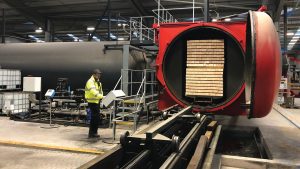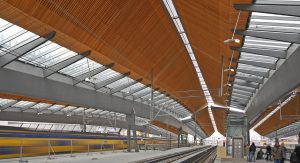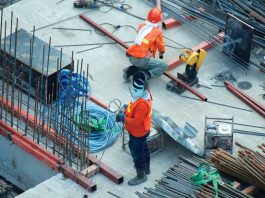Gordon Ewbank, CEO of the Wood Protection Association, talks to The Innovation Platform’s Managing Editor Michelle Gordon about the benefits of building with timber and how technology is being used to improve the material’s performance.
The use of timber in the built environment is steadily increasing, driven largely by its excellent environmental credentials, but the material is not without its limitations and technology has a part to play in enhancing its properties to unlock new markets.
Timber has been used as a construction material throughout history but as climate change continues to top political agendas across the globe, and as governments introduce ever more ambitious carbon reduction targets, we are starting to see a resurgence in its use in the modern built environment.
The environmental credentials of timber are excellent as it has the potential to save millions of tonnes of carbon through carbon sequestration – the process of capturing and storing atmospheric carbon dioxide – with an average three-bedroom, timber-framed house sequestering and storing around 19 tonnes of CO2.
The Wood Protection Association is the UK’s lead body on all matters concerning wood protection and its members range from large multi-national timber treatment manufacturers to SMEs, partner trade associations, and individuals such as researchers or scientists.
The organisation’s CEO Gordon Ewbank talks to The Innovation Platform’s Managing Editor Michelle Gordon about the benefits of building with timber, its potential contribution to carbon reduction targets, and how technology is being used to improve the material’s performance and open up new applications.
Can you outline the role of the Wood Protection Association?
The Wood Protection Association (WPA) represents a specialised and very technical, but important nonetheless, aspect of the timber industry. We are timber specialists, in so much as timber is the material that we are working with; but actually what we do is chemistry.
Our members are associated with enhancing the properties of timber, so taking all of the benefits of using timber in various applications and enhancing those through either the addition of specialist chemical formulations to improve those properties or the modification of the wood substrate itself through chemical processing. We represent pretty much the entire supply chain and we have got some good research and development projects being carried out under the WPA banner.
It is a very interesting sector to be involved in, and although what we as WPA and our members do is chemistry- and processing-orientated, essentially what we are doing is helping to make a really good product even better, and making the most of wood as a construction material by enhancing the properties to open up new markets.
What are the main benefits of using timber as a construction or landscaping material within our built environment?
Timber has a lot going for it. It is flexible and versatile as a building material and, on the whole, it is quicker to put up a timber building than one made of brick, for example. It is also an extremely good insulating material.
There is much more focus these days on the impact of our environment on health and wellbeing and on healthy working environments and living spaces. Timber can play a significant part in this and there is some very interesting research about the mental health impacts of a working or living environment with a lot of timber in it.
Timber is also very much part of modern methods of construction, offsite construction, and the drive towards factory production of construction building modules and that is something that very much has the government’s backing.
When I joined the industry some years ago, we didn’t talk about environmental impact; now, we talk about virtually nothing else because carbon capture data with timber is second to none compared to other building materials. If you do a lifecycle assessment, you actually get positive impacts in terms of carbon from using timber.
Obviously, these things have to be combined with sustainable forest management and the sustainable and responsible procurement of timber, but the industry has done huge amounts on that over the last few decades and we are in a strong place.

What role will timber play in meeting future carbon reduction targets?
It has been demonstrated quite clearly that the more timber you can use in a building, the better the carbon profile of that building will be. There are some applications for timber where its natural properties are more than adequate for what you want. However, there are others, particularly when the timber is exposed to weather or is below a damp proof course or in contact with the ground etc., where it is going to be damp regularly or even permanently. In such applications, most of the sustainable soft wood used for construction would require some added durability to perform long term. That is where our industry comes in. It is about using the right technology and the right application to get the best and most cost-effective performance. It is not rocket science, but it does need good understanding, particularly amongst building designers, of what technology is available and what the various benefits of the different options are, and we play a big part in helping to educate people on that.
How have technologies and wood modification processes been used to enhance and improve timber’s performance?
There are three areas: wood preservation; modification, which is a broader range of technologies; and flame retardants.
Wood preservation involves enhancing the durability of timber through the addition of chemicals. It is an old, traditional industry in many ways, as creosote was first impregnated into the railway sleepers some 200 years ago. But we have moved on a long way since then. A lot of the chemistries we are using are very different to what was used 50, or even 30 years ago.
The advantage of these technologies is that they take a completely sustainable, renewable resource and extend its service life by four, five, six, or potentially even seven times. This could even involve changing something that might have been a waste material into a useful product simply by enhancing its durability, so that it continues to find new markets.
The traditional market for wood protection has been within buildings and the construction envelope, but in the last 10-15 years we have seen growth in the imaginative use of timber outdoors, in decking, for example, which is still a huge growth market.
The use of biocides, which prevent the growth of biological organisms, fungal decay, insects etc. but which are relatively benign to users, has been important for our members. The industry has made massive steps forward in the last 30 years here, and that has been the result of significant expenditure on research and development, which continues now.
Modified wood is a really exciting area. There is a whole variety of technologies under the heading of wood modification but the essence of them all is that rather than adding a chemical into the wood to change its properties, the chemical nature of the wood itself is being changed. So, rather than adding biocides the substrate is being changed so it is less attractive to decay organisms, for example. Some of those technologies use chemicals to modify the timbers, while others use heat.
It is an exciting area because the range of different products coming out of that are expanding the potential uses for timber. There is one branch of wood modification that is enhancing the durability of the wood so much that timber is going back into what was an old market in marine applications. Timber was really phased out of marine applications and even to some extent freshwater applications when creosote was effectively lost to those markets and there were no other preservation technologies quite up to the job. However, certain types of modified wood are very much up to the job, giving excellent long-term performances in some very hazardous environments, and they look great as well. It is still a growth area, however, as these technologies are fairly new; but they will undoubtedly grow in influence over the coming years.
Finally, there is the fire performance of timber and, again, there has been a lot of innovation in that area in recent years. The enhancement of the reaction to fire properties of timber substrates is not a new concept, as impregnation treatments have been around for some 60 or 70 years and still are, albeit with different chemistries. Nevertheless, the exciting innovations in recent years have involved moving the enhancement processes up the supply chain.
So, flame retardant treatments used to be a secondary process, something that was done to a solid piece of timber or a sheet material down the supply chain, where an untreated product would be treated to enhance its properties.
Now, the real growth area is in the production of engineered wood products and sheet materials with flame retardant additives built in at manufacture. So, products such as MDF, OSB, plywood, and some of the laminated timber products are now actually manufactured with the flame retardants in them. That has numerous advantages, in that you have the factory production controls of both the application and the fine tuning of the properties of the product, with all the CE marking and certification that goes with that; it just gives you a more consistent product.
It is a real growth area and a great example of where innovation is addressing a market need for higher performing products, not least in the fallout from the Grenfell tragedy; standards are changing, and people are demanding more, quite rightly, of building products. I think that this sector of our industry has really risen to that challenge.

How are these processes enabling timber to be used in new applications?
I think there is a greater awareness now of what wood preservation technologies can do amongst specifiers and, therefore, it is freeing people up to use timber outdoors in a way that they were not doing before. That is a combination of technology meeting design innovation.
On the wood modification side, there is the obvious opening up of really high hazard applications. Timber had lost those markets, but is now looking to get back into them.
With flame retardants, the Hackitt Review was absolutely accurate in highlighting issues of confidence and quality control down the supply chain, as well as a need for more factory production control of different elements. The new engineered timber products with built in flame retardancy tick all the boxes, and it is very much the way the industry is developing and moving.
What will be the main areas of focus for the WPA over the next couple of years?
Industry can come up with some really great ideas but if you don’t communicate them to the market, they are not going to go anywhere. The challenge for us is therefore supply chain education and opening people’s eyes to timber’s potential.
We will also continue to be active in the area of independent third-party quality assurance. Fire is a really obvious area where people are looking for more reassurance and confidence and we run a number of quality schemes to audit members and their processes and products.
Finally, working with the government on developing appropriate and proportionate regulatory frameworks will also remain a focus. By that, I don’t mean trying to look for loopholes, it is about helping the government to understand that it is possible to regulate an industry without completely stifling innovation. The result of inappropriate legislation that is too heavy handed is that industries no longer invest in innovation; they just exit a particular market because it is not worth the hassle. The government has a role to play by working with and encouraging that industry to adopt the standards that it wants it to meet. There are good examples of that, but it only really works when government and industry work together.
Gordon Ewbank
CEO
Wood Protection Association
+44 (0)1977 558274
gordon@thewpa.org.uk
www.thewpa.org.uk
Please note, this article will also appear in the fourth edition of our new quarterly publication.





